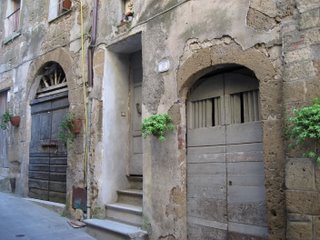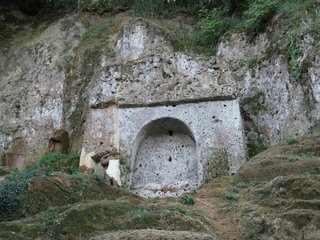Throughout much of Italy, particularly in the Tuscan region, there are many Etruscan archaeological areas that have been uncovered and explored--and many still left to find. From these there is emerging insight into the people and customs, but understanding still remains both elusive and limited.
As you drive along the roads between villages, it is not uncommon to see little brown signs pointing up a hill or down a white road indicating somewhere in that direction can be found the remains of an Etruscan tomb. But--after chasing these signs a few times, you know that when you find it, you will probably be disappointed. Often what is at the end of that rainbow is very little--a mound, a small dirt enclosure, a gate that is locked--you are denied your quest after the journey. Once in a while though you are rewarded by a rare treat that makes you feel special for having seen it and then all the blind roads you have taken become worth it.
However--if you do your research, read your guide books, check the vast resources of the internet, talk with people, you will be able to plan time and itinerary to explore the special places where there is more to see and ponder. Such are the areas around the medieval hilltop towns of the Fiora valley in the Maremma hills of Tuscany--Pitigliano, Sovana and Sorano.
 Pitigliano is by far the largest of the three towns. It is an incredible site as you approach it and see it towering above you--seemingly a carved extension of the rock on which it is built. Once there you find a warren of lanes, blind alleys, curving narrow streets and steps. And, perhaps most interesting, are the structural remains of a medieval Jewish community.
Pitigliano is by far the largest of the three towns. It is an incredible site as you approach it and see it towering above you--seemingly a carved extension of the rock on which it is built. Once there you find a warren of lanes, blind alleys, curving narrow streets and steps. And, perhaps most interesting, are the structural remains of a medieval Jewish community.This community was established in
the 16th century because of persecution within the papal states. Today there are remains of several buildings, including the refurbished synagogue,the ritual baths, the Unleavened Bread Bakery and the
wine cellar. There is also a small museum of Jewish culture in what was the first school and religious center.
Sovana and Sorano are very small villages that have periodically flirted with extinction but somehow have survived and now are destination places with hotels and restaurants. They, too, are interesting villages to explore--neither requiring much time.
 In Sorano there is a very old fortress which has had little outside restoration but has one wing that has become small hotel. We stayed there Halloween night and found it fascinating and fun --particularly as we were the only guests and the entire staff went home at 10:30. Our room was lovely and the view over medieval Sorano from our window was beautiful--even more so at night.
In Sorano there is a very old fortress which has had little outside restoration but has one wing that has become small hotel. We stayed there Halloween night and found it fascinating and fun --particularly as we were the only guests and the entire staff went home at 10:30. Our room was lovely and the view over medieval Sorano from our window was beautiful--even more so at night. Sovana, unlike Pitigliano and Sorano is flat and small and easy to walk. The Church of Santa Maria in the main piazza has an incredible altar piece from the 8th century and some lovely frescoes. At the other end of town is the fascinating Il Duomo which really should be visited. And past that are some Etruscan ruins
Sovana, unlike Pitigliano and Sorano is flat and small and easy to walk. The Church of Santa Maria in the main piazza has an incredible altar piece from the 8th century and some lovely frescoes. At the other end of town is the fascinating Il Duomo which really should be visited. And past that are some Etruscan ruins
The Marble Altar in Santa Maria

In Sovana there is now a beautiful 4**** hotel for those who like to splurge--or for those for whom such a place is not a splurge--Sovana Hotel and Resort. Part of the structure is medieval but much of it has been recently built. There are exquisitely manicured grounds to stroll and a pool. It would be a nice place to stay for a couple of nights while exploring the Fiora Valley towns; however, my choice would remain the Hotel della Fortezza in Sorano just because it is such a different experience. Resorts are anywhere -- fortezzas are few (ask for room 16.)
 But--for the adventurer in search of mystery, it is outside of Sorana that holds the intrigue. It is in the valleys, crevices and hills surrounding these villages that you discover the Etruscans. Here you find ancient pathways carved out of mountains--barely wide enough for one person to traverse--with high straight walls covered with moss. You can only marvel and ask "how did they do it?"
But--for the adventurer in search of mystery, it is outside of Sorana that holds the intrigue. It is in the valleys, crevices and hills surrounding these villages that you discover the Etruscans. Here you find ancient pathways carved out of mountains--barely wide enough for one person to traverse--with high straight walls covered with moss. You can only marvel and ask "how did they do it?"The Hildebrand Temple Tomb

In the Sovana area there are examples of the different types of Estruscan tombs--some of them very elaborate indicating the high degree of sophistication and artistic capabilities of these people who survived for 10 centuries--beginning somewhere around VIII BC--and who taught the Romans much. And, because all the major types of funerary architecture of the region can be found here---chamber tombs, facade tombs, niche tombs, burial ditches and incredible temple tombs--,it is quite unique.
A Facade Tomb

In some of the Etruscan burial chambers which are carved out high on the mountains are found Christian crosses and, even in one case, a Madonna and Child fresco. These were carved by hermits who used these chambers as homes in medieval times.
Niche or little cave like tombs are numerous throughout the area and would have been the most common type. As you can see, Casey had fun with them.

We had time to explore just a little of this wonderland and so have plans to return. Many of the objects found by the archaeologists are now located in museums in Orvieto, Siena and others in the immediate area, as well as Etruscan museums throughout Tuscany--Firenze, Fiesole, etc, etc., etc. We feel fortunate in having visited many of these museums over the years. We had a better understanding of what these tombs had held and an appreciation for the people who had created them. Seeing the tombs without that background would be less meaningful. So.........our recommendation is that you hit the museums first and then explore.
Niche or little cave like tombs are numerous throughout the area and would have been the most common type. As you can see, Casey had fun with them.

We had time to explore just a little of this wonderland and so have plans to return. Many of the objects found by the archaeologists are now located in museums in Orvieto, Siena and others in the immediate area, as well as Etruscan museums throughout Tuscany--Firenze, Fiesole, etc, etc., etc. We feel fortunate in having visited many of these museums over the years. We had a better understanding of what these tombs had held and an appreciation for the people who had created them. Seeing the tombs without that background would be less meaningful. So.........our recommendation is that you hit the museums first and then explore.

No comments:
Post a Comment